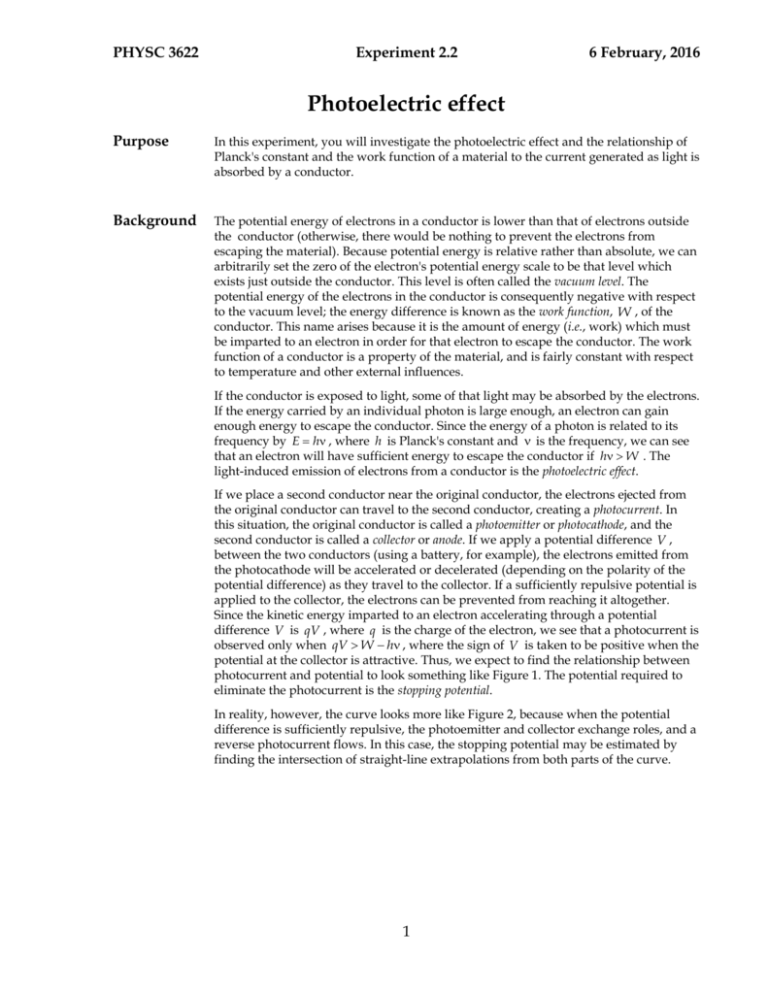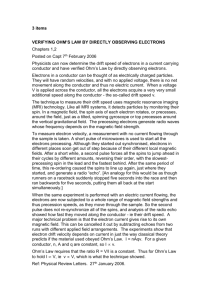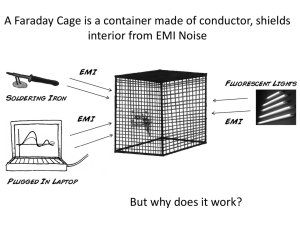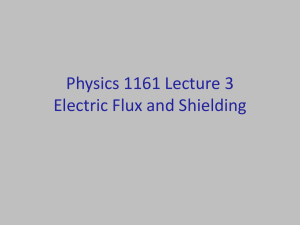Experiment 2-2
advertisement

PHYSC 3622 Experiment 2.2 6 February, 2016 Photoelectric effect Purpose In this experiment, you will investigate the photoelectric effect and the relationship of Planck's constant and the work function of a material to the current generated as light is absorbed by a conductor. Background The potential energy of electrons in a conductor is lower than that of electrons outside the conductor (otherwise, there would be nothing to prevent the electrons from escaping the material). Because potential energy is relative rather than absolute, we can arbitrarily set the zero of the electron's potential energy scale to be that level which exists just outside the conductor. This level is often called the vacuum level. The potential energy of the electrons in the conductor is consequently negative with respect to the vacuum level; the energy difference is known as the work function, W , of the conductor. This name arises because it is the amount of energy (i.e., work) which must be imparted to an electron in order for that electron to escape the conductor. The work function of a conductor is a property of the material, and is fairly constant with respect to temperature and other external influences. If the conductor is exposed to light, some of that light may be absorbed by the electrons. If the energy carried by an individual photon is large enough, an electron can gain enough energy to escape the conductor. Since the energy of a photon is related to its frequency by E h , where h is Planck's constant and is the frequency, we can see that an electron will have sufficient energy to escape the conductor if h W . The light-induced emission of electrons from a conductor is the photoelectric effect. If we place a second conductor near the original conductor, the electrons ejected from the original conductor can travel to the second conductor, creating a photocurrent. In this situation, the original conductor is called a photoemitter or photocathode, and the second conductor is called a collector or anode. If we apply a potential difference V , between the two conductors (using a battery, for example), the electrons emitted from the photocathode will be accelerated or decelerated (depending on the polarity of the potential difference) as they travel to the collector. If a sufficiently repulsive potential is applied to the collector, the electrons can be prevented from reaching it altogether. Since the kinetic energy imparted to an electron accelerating through a potential difference V is qV , where q is the charge of the electron, we see that a photocurrent is observed only when qV W h , where the sign of V is taken to be positive when the potential at the collector is attractive. Thus, we expect to find the relationship between photocurrent and potential to look something like Figure 1. The potential required to eliminate the photocurrent is the stopping potential. In reality, however, the curve looks more like Figure 2, because when the potential difference is sufficiently repulsive, the photoemitter and collector exchange roles, and a reverse photocurrent flows. In this case, the stopping potential may be estimated by finding the intersection of straight-line extrapolations from both parts of the curve. 1 PHYSC 3622 Experiment 2.2 6 February, 2016 Figure 1. Ideal photocurrent vs. stopping potential curve. Figure 2. Observed photocurrent vs. stopping potential curve. Procedure You will use a mercury vapor lamp as the light source in this experiment. Mercury vapor emits light at a number of discrete wavelengths from the near ultraviolet to the near infrared portion of the electromagnetic spectrum. To select light of a particular wavelength, you will use interference filters. First, turn on the stopping potential power supply and the meters. Next, turn on the mercury lamp. To turn on the lamp, record the position of the polarity switch on the front panel (either + or –). Move the switch to the AC position and turn the power supply on. The lamp will flicker for several seconds; when it stabilizes, move the polarity switch to the other polarity (that is, if it was in the – position previously, move it to the + position, and vice versa). Allow the instruments to warm up and stabilize for at least ten minutes. Insert a filter into the filter holder between the light source and the phototube (start with the 365.0 nm filter). Using the potentiometer to vary the potential difference between the photoemitter and collector, record a current vs. voltage curve. Be sure to record a sufficient number of points that you can extrapolate the two portions of the curve to find the stopping potential. Repeat this procedure for each of the remaining wavelengths (you may find that there is insufficient light intensity at 690.4 nm to observe any measurable photoelectric effect). 2 PHYSC 3622 Experiment 2.2 6 February, 2016 Using Sigma Plot, plot the stopping potential as a function of photon frequency. Determine the best-fit straight line through your points. The slope of this line is related to Planck's constant, while the y-intercept is proportional to the work function of the photoemitter. Questions How does your fitted value of Planck's constant compare with the published value? The photo-cathode used in the experiment is made of an alloy of Sb and Cs on a Ni substrate. How does your fitted value of the work function compare with those for S b and Cs? (You can find the work functions of typical metals in Solid State Physics by N. W. Ashcroft and N. D. Mermin, p.364.) What are the potential sources of error in this experiment? (Be sure to consider the possible errors in each stage.) 3








